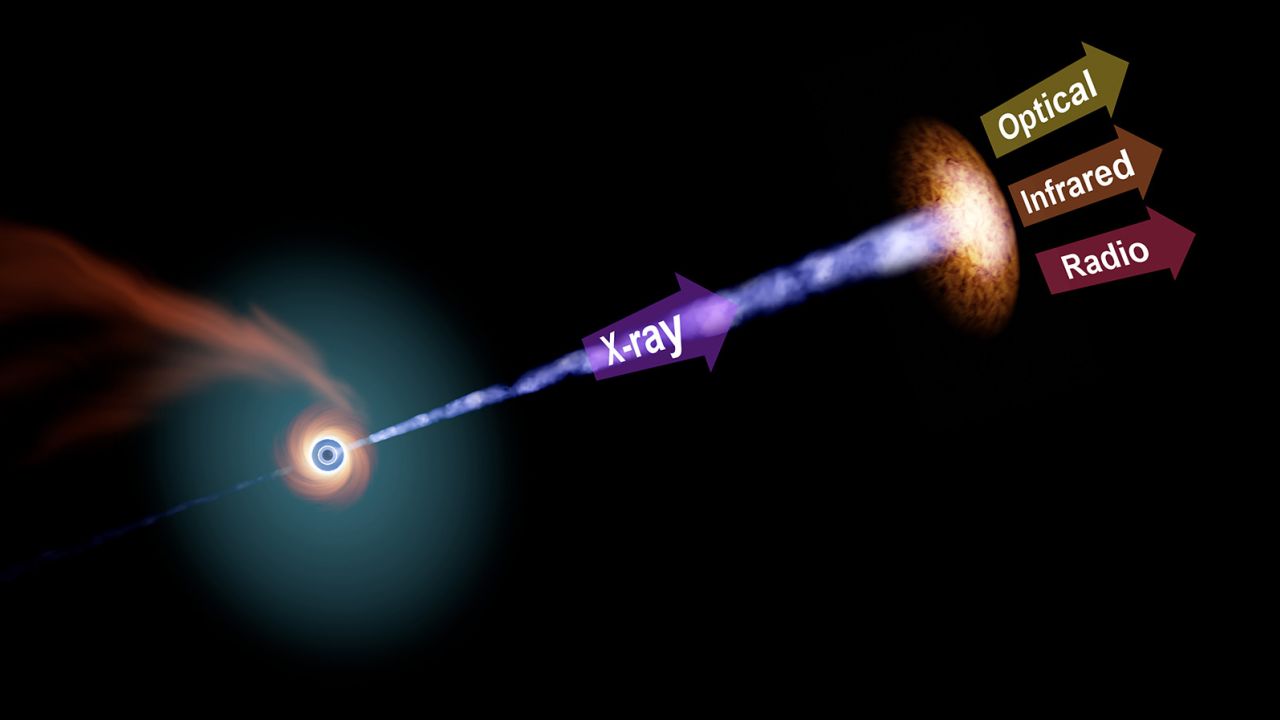A Rare Cosmic Event Emitted Light About 8.5 Billion Light Years Away From Earth
The very brilliant light seen in February was caused by a star that had wandered too near to a supermassive black hole and been torn to pieces. More questions than answers have been raised as rare cosmic event emitted light that happened 8.5 billion light-years from Earth when the universe was just a third of its present age.
Author:Karan EmeryReviewer:Daniel JamesDec 02, 2022101.9K Shares1.7M Views

According to CNN,the very brilliant light seen in February was caused by a star that had wandered too near to a supermassive black hole and been torn to pieces. More questions than answers have been raised as rare cosmic event emitted lightthat happened 8.5 billion light-years from Earth when the universe was just a third of its present age.
The bright explosion, designated AT 2022cmc, was originally detected on February 11 by the Zwicky Transient Facility at the Palomar Observatory at the California Institute of Technology.
A tidal disruption event occurs whenever a star is ripped apart by the gravitational pull of a black hole. Although similar violent phenomena have been recorded by astronomers before, AT 2022cmc is far more luminous than anything else of its kind. It's also the furthest object ever seen in the sky.
Video unavailable
This video is unavailable: Original link to video
Supermassive Black Holes Emit Bright Lights
Astronomers think that as the black hole swallowed up the star, it released a huge quantity of energy and sent a jet of material speeding through space at almost the speed of light. The "Doppler-boosting" effect caused AT 2022cmc to look so brilliant in our sky.
The finding may show how supermassive black holes form and eat stars. Wednesday saw two Nature Astronomy and Nature investigations on the incident. Gamma-ray bursts, X-ray jets created when huge stars collapse, explain the brightest night sky flares.
“„Gamma-ray bursts are the usual suspects for events like this. However, as bright as they are, there is only so much light a collapsing star can produce. Because AT 2022cmc was so bright and lasted so long, we knew that something truly gargantuan must be powering it — a supermassive black hole- Dr. Benjamin Gompertz, Nature Astronomy
The International Space Station's X-ray instrument, NICER, analyzed the signal. Dheeraj Pasham, main study author of the Nature Astronomy report and a research scientist at MIT's Kavli Institute for Astrophysics and Space Research, said AT 2022cmc was "100 times more intense than the most powerful gamma-ray burst afterglow" previously observed.
This artist's impression depicts the binary system VFTS 243 from close up. The Tarantula Nebula in the Large Magellanic Cloud contains a bright, blue star with 25 times the Sun's mass and a black hole at least nine times the Sun's mass. The blue star is really 200 000 times bigger than the black hole. The black hole's "lensing" effect is only exhibited to highlight it. Earth's tilt prevents us from seeing the black hole eclipse the star.
The star was split apart and then sucked into the spinning disk around the black hole's point of no return. As it plunged towards the black hole, the torn star generated a debris whirlpool that emitted intense X-rays.
Unusual Cosmic Events
One of the greatest observatories for observing the cosmos and detecting transient astronomical phenomena is the Zwicky Transient Facility. After AT 2022cmc's first detection of the signal, several other ground and space-based telescopes zeroed in on it, giving us a stunningly detailed glimpse at the very unusual occurrence.
Artist's conception of a black hole passing across our Milky Way galaxy. A enormous star collapsed in on itself and detonated as a supernova, leaving behind the squashed remnant that is the black hole. The mass of the intact core is comparable to that of many Suns. Because of its strong gravitational pull, the black hole is able to absorb light. Images of stars in the backdrop that are aligned nearly exactly behind the black hole are warped because of the distortion of space around the black hole.
Perhaps as many as a hundred million solitary black holes roam the Milky Way, and the only way we know they exist is by the gravitational "lensing" effect. Hubble Space Telescope searches for them by detecting the distortion of starlight caused by the passage of black holes in front of background stars.
The Hubble Space Telescope caught the infrared and visible light generated by the event, while the Very Large Telescope at the European Southern Observatory in Chile was used to calculate its distance from Earth. In New Mexico, radio waves were detected by the Karl G. Jansky Very Large Array of telescopes.
Approximately one percent of tidal disruption events produce relativistic jets (or beams travelling near the speed of light) that shoot plasma and radiation from the poles of a revolving black hole.
“„The last time scientists discovered one of these jets was well over a decade ago.- Michael Coughlin, University of Minnesota
“„Astronomy is changing rapidly. Scientists can use AT 2022cmc as a model for what to look for and find more disruptive events from distant black holes.\- Igor Andreoni, University of Maryland
Final Words
Even while astronomers have a good idea of what causes certain tidal disruption events to produce jets and not others, it's likely that the black hole has to be spinning at an especially high rate in order to produce a jet at all.
Researchers believe that if they see enough such instances, they will learn how black holes generate such strong jets.

Karan Emery
Author
Karan Emery, an accomplished researcher and leader in health sciences, biotechnology, and pharmaceuticals, brings over two decades of experience to the table. Holding a Ph.D. in Pharmaceutical Sciences from Stanford University, Karan's credentials underscore her authority in the field.
With a track record of groundbreaking research and numerous peer-reviewed publications in prestigious journals, Karan's expertise is widely recognized in the scientific community.
Her writing style is characterized by its clarity and meticulous attention to detail, making complex scientific concepts accessible to a broad audience. Apart from her professional endeavors, Karan enjoys cooking, learning about different cultures and languages, watching documentaries, and visiting historical landmarks.
Committed to advancing knowledge and improving health outcomes, Karan Emery continues to make significant contributions to the fields of health, biotechnology, and pharmaceuticals.

Daniel James
Reviewer
Daniel James is a distinguished gerontologist, author, and professional coach known for his expertise in health and aging.
With degrees from Georgia Tech and UCLA, including a diploma in gerontology from the University of Boston, Daniel brings over 15 years of experience to his work.
His credentials also include a Professional Coaching Certification, enhancing his credibility in personal development and well-being.
In his free time, Daniel is an avid runner and tennis player, passionate about fitness, wellness, and staying active.
His commitment to improving lives through health education and coaching reflects his passion and dedication in both professional and personal endeavors.
Latest Articles
Popular Articles